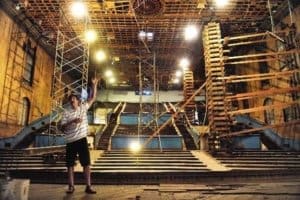News: In the News
Holly Theater Slated for Facelift
Ausland played an important role in the scoping and cost analysis of the (formerly MURA) facade renovation grant described in this article. Exciting times for the proliferation of the arts in Southern Oregon!
Supporters of the Holly Theatre hope to go prime time with their restoration efforts if Medford officials agree to provide $300,000 in seed money.
The Jefferson Public Radio Foundation has requested from the Medford Urban Renewal Agency board a matching $100,000 improvement grant to restore the front of the building to what it looked like when the theater opened in 1930.
The facade grant will be discussed during a MURA meeting at noon Thursday at City Hall, 411 W. Eighth St. It would pay for a new neon marquis, new front doors and a neon mast at the corner of the building.
In addition, JPR, which purchased the building last year, wants another $200,000 to repair a broken truss supporting the roof and to perform other demolition and cleanup work. MURA had set aside $200,000 in its budget to help with the Holly restoration, though it was anticipating possibly awarding the money sometime next year.
JPR undertook a similar project in Redding, Calif., fully restoring the Cascade Theatre.
Ron Kramer, executive director of JPR, said preliminary structural analysis of the truss indicates it can be saved and the roof won’t have to be demolished as originally feared.
“We don’t believe the truss will require $200,000 to repair,” he said.
A $37,500 structural analysis of the broken truss and others and design for the repairs will be conducted in the near future. The design could include a cable-tension system used to repair a cracked beam in the Bowmer Theatre in Ashland that cost the Oregon Shakespeare Festival $500,000. However, the truss at the Holly should be cheaper because it doesn’t support the same kind of loads.
Kramer said the truss, damaged by a leaking roof, needs to be repaired so that JPR can bring in tours that will help with fundraising activities.
If JPR receives both grants from the city, it will help boost fundraising efforts, he said.
“The city would be making a formal statement that it is recommending the Holly,” Kramer said.
In 2002, Medford officials ordered the building vacated after the truss snapped.
Since then, the failed truss has been held up by makeshift supports.
Chris Reising, Medford’s public works director, said he has recommended the Holly have limited occupancy at present because of structural issues with the roof, though JPR helped take some of the weight off the truss by removing a lot of the old ceiling.
Once the truss is fixed, groups of about 10 could be allowed inside the building for touring, Reising said.
He said public works crews likely will take a look at the proposed repairs that will be recommended by the engineer hired by JPR.
The MURA board previously rejected JPR’s request for a facade improvement grant primarily because JPR didn’t own the building at the time.
Kramer said structural analysis of the building, which has reinforced concrete walls, has been surprisingly good.
So far, Kramer said JPR estimates the building can be restored and improved with modern lighting and sound equipment for $3.5 million.
JPR has cleaned out the building, fixed the lighting and made other improvements that give a better idea of its former grandeur. Since the cleanup, JPR has shown the building to individual City Council members and other local officials.
By Oct. 1, the JPR board will select an architect for the project.
Once the facade and truss work are completed, Kramer hopes to hold a dedication ceremony next spring that will give local residents a firsthand look at the interior.
George Kramer, a preservation consultant and Ron’s brother, said enough remnants of the Spanish colonial building designed by local architect Frank Clark have been found to give a good idea what it formerly looked like.
“We’ve found some of the original carpet, which we can replicate,” he said. “The general colors were greens, reds and golds.”
Original light fixtures have been found, though Kramer and others are looking for other features from the old building, including the “Ladies” and “Gentlemen” signs next to the bathrooms.
The theater itself was designed to provide the feel of being in the middle of a Spanish courtyard complete with balconies.
“We can make this a truly restored, state-of-the-art theater,” Kramer said.
Reach reporter Damian Mann at 541-776-4476, or e-mail dmann@mailtribune.com.
Ausland Group | September 26, 2011







 Facebook
Facebook LinkedIn
LinkedIn